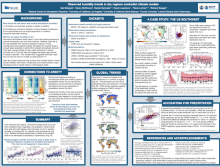Observed humidity trends in dry regions contradict climate models
Isla
Simpson
NCAR
Poster
Arid and semi-arid regions of the world are particularly vulnerable to greenhouse gas driven hydroclimate change. The American Southwest is a particularly clear example where recent drought has led to unprecedented water shortages in the Colorado River, and some of the most extreme wildfire seasons in recent history, and this has almost certainly been exacerbated by the substantial warming and aridification that has resulted from rising greenhouse gases. Climate models are our primary tool for projecting the future hydroclimate that society in these regions must adapt to, but here a concerning discrepancy between observed and model-based historical hydroclimate trends will be discussed. While observations of many of the processes of relevance to the hydroclimate, such as soil moisture and evapotranspiration, are limited, we do have a reasonably complete network of station-based near surface atmospheric humidity measurements as well as reanalysis-based estimates of atmospheric water vapor. Here, we will use these datasets along with CMIP6 models to demonstrate a rather drastic difference in the nature of near surface humidity trends between models and observations in arid and semi-arid regions over the period 1980 to 2020. It will be shown that models tend to exhibit increases in atmospheric water vapor that are close to those expected from Clausius Clapeyron scaling, while atmospheric humidity in reality has stayed roughly constant over arid and semi-arid regions of the world. This suggests that the availability of moisture to satisfy the increased atmospheric demand is lower in reality than in models in arid and semi-arid regions and it indicates a major gap in our understanding and modeling capabilities, which could have severe implications for hydroclimate projections, including fire hazard, moving forward.

Poster file
simpson-isla-confronting-poster.pdf
(2.95 MB)
